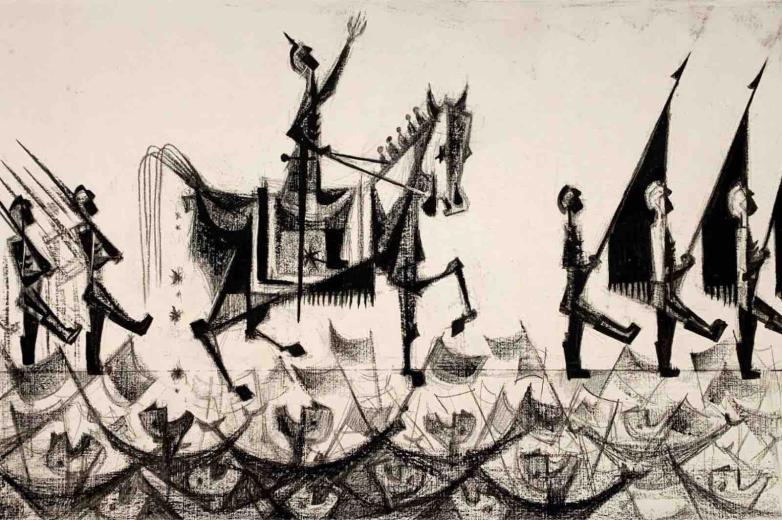Si Lewen's The Parade on Show at The Menil Collection

Untitled drawing from Si Lewen, The Parade, ca. 1950. Charcoal, crayon, and tusche on
gessoed board, sheet: 12 × 18 inches (30.5 × 45.7 cm).
The Menil Collection is presenting exhibition of drawings by Polish-born American artist Si Lewen (1918-2016), made in preparation for his groundbreaking graphic novel about the never-ending cycle of war, The Parade (1957). All 55 original drawings reproduced in the book are being exhibited at the museum in Houston, Texas, along with eight additional related works. The complete set has never before been exhibited in the United States.
Without a single written word, The Parade tells the story of events that the artist experienced first hand: armistice parades after World War I, the rise of Nazism, World War II, the Holocaust, and finally, post war celebrations. More broadly, the drawings speak to the cycle of war, the seductive glory and pomp, followed by soldier enlistment, community deprivation, devastating destruction, death, and heartbreak. When the war ends, the cycle repeats.
The Parade begins with images of children and families making their way towards a celebration. After watching a military parade, children wearing paper hats pretend to fight one another. All too soon, they are given deadly weapons, and what once seemed like lighthearted fun morphs into a nightmare. The drawings represent devastation, desolation, and death. Menacing shadows and a dark, ominous tone convey the shock and horror of war. The series unfolds cinematically, sequentially connecting one image to another to create a powerfully moving work of art. Lewen used a limited tonal range, illustrating his darkest moments of war in which all color seemed to have vanished.
Rebecca Rabinow, Director, The Menil Collection, said: “Si Lewen’s unsparing narrative captures the cycles of rhetoric and militarism that first produce excitement and pride before giving way to terror and destruction. The Parade is both a visual documentation of the political upheaval that led to the Holocaust, and also a nuanced articulation of the cycles of violence that have existed for millennia.”
A Polish Jewish refugee, Si Lewen grew up in Germany, where he observed the political and cultural upheaval happening around him. In 1933, when Hitler came to power, he fled to France with his brother and later immigrated to the United States, enlisting in the U.S. Army and joining an elite unit of German-speaking special forces called “The Ritchie Boys.” He saw action in Normandy and visited the Buchenwald concentration camp shortly after its liberation in 1945; he was devastated by atrocities of the Holocaust.
After returning to America, Lewen resumed his art in an effort to heal from his trauma. Completed around 1950 and published in 1957, The Parade was the culmination of this phase of his work. Although Lewen transformed his personal memories into these drawings, he knew they could not express the real-life terrors he witnessed. Lewen said: “Did I succeed? Can others now see what I saw? The answer is ‘no’. No matter how well articulated or skillfully
created, ‘horror’, for instance, means little except to those who have also experienced it.”
The book, which today is little remembered, received numerous accolades when it was published. Through his gallerist Lotte Jacobi, Lewen sent an early mock-up of The Parade to Albert Einstein shortly after it was completed. Einstein wrote to Lewen: “I find your work, The Parade, very impressive from a purely artistic standpoint... It has often been said that art should not be used to serve any political or otherwise practical goals. But I could never agree with this point of view... Our time needs you and your work!”
Si Lewen: The Parade is organized by Kelly Montana, Assistant Curator at the Menil Drawing Institute and will be on view at the Menil Drawing Institute April 21–September 3, 2023.















